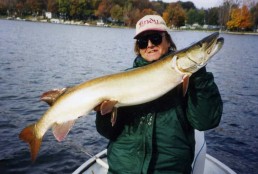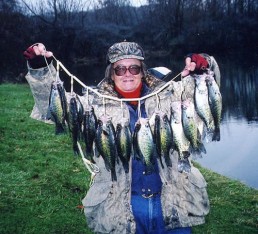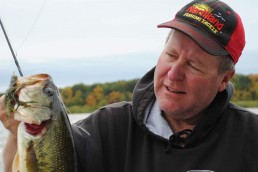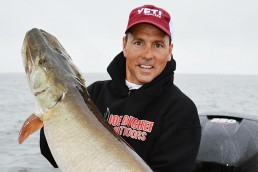Trophy Time: Late Fall Can Yield Big Fish
SHARE THIS POST
Starting this month and over the next few, there is some of the best fishing of the entire season. Most anglers really pound the water during early spring and early summer. They know that big fish are accessible with many species in shallow water feeding aggressively, preparing for their spawning ritual. Many may hit it hard the entire warm-water period, while others may slack off during the midsummer “dog days.” Some anglers may not even pick up a rod again until next spring.
It is just too easy in fall to let other things come before fishing: chores around the house, various waterfowl seasons, football or other reasons. Some are just fair-weather fishermen and prefer not to go out on the water when it’s cold.
But bundle up, and give fishing in autumn an honest try. It’s a beautiful time to be on the water with the leaves turning colors and the fishing pressure is down on most waters and the fish are feeding—trophy fish.
Some of the largest of the season are taken in fall. Panfish, bass, muskies, walleyes, etc., all binge prior to the cold.
The water temperatures are dropping with less daylight and the cooler days and evenings. Another plus for fall fishing is that it is not necessary to get up at the crack of dawn as you would other seasons. Fish may feed throughout the day, and the hours from noon to dusk may be the most productive. Indian summer days may also trigger some of the most aggressive feeding sprees by the fish, especially the big trophies you dream about.
Location
Finding the fish is one of the keys to catching a trophy. This will vary as the season progresses, but for the early part of fall, weed edges will be prime spots. Weed beds are very thick now, and cover is at its best. Ambush cover will be best at the weed edge toward the deeper water. These are the early-fall feeding grounds for big pike, muskies, walleyes, bass and large panfish.
Other good spots are rocky drop-offs and breaklines that extend into deeper water. You may have to spend some time working the different depths along the drop-offs, but once you find fish, the numbers using this structure may surprise you.
The lush weed beds will slowly die off, but not all of them. The remaining green, healthy weeds become a “drawing card” for trophy fish. Again, you’ll have to spend time locating these areas, but you may be rewarded with that trophy of a lifetime.
There will also be some feeding taking place in shallower waters. Activity can be here at midday or in the afternoon on some days, but night fishing in these areas can be even better. I have enjoyed some great fishing after dark for walleyes, largemouths, white bass and crappies—even though it was so cold you had to wear a snowmobile suit to stay warm.
Are you enjoying this post?
You can be among the first to get the latest info on where to go, what to use and how to use it!
Equipment
Take extra care in checking out your equipment beforehand, and don’t allow any failure or breakdown cost you that trophy.
Match your equipment with that trophy fish in mind, using rods comparable to the approximate size of fish you are after. More large fish are landed on quality equipment than on second-rate bargains. I use 100-percent graphite rods for all my fishing because of the sensitivity and strength. Most quality rods today are capable of tangling with that trophy, but it’s important to go with dependable reels too. You’ll need a quality reel with a smooth drag. Without a smooth drag, you will not land what you want. Remember, big fish have grown to trophy size because they have a keener instinct for survival.
Match your line strength to the job at hand, whether flipping the weed edges, casting the rocks or working the drop-offs. Do not trust landing a big fish on the same line that you may have been using since spring. If you’re really serious about putting the odds in your favor, then spool up with fresh, new line. Also, make sure hooks are sharp. Touch them up before you bait the hook or make a cast. Take care when tying knots and retie them after landing large fish or recovering snagged bait.
The big-bait factor
Bait types will vary with the species you are after, but think “big.” You are after larger fish, so use the bigger baits. This is a proven fact for fall fishing. Whether artificial or live bait, it should be sizeable enough to entice a trophy.
Even panfish will go for larger-sized minnows in fall than at any other time of the year, so use that larger bait.
Presentation
Trophy-sized fish didn’t get to be that big by gulping down all bait in front of them. Again, these have a highly developed instinct for survival and have been around for a while. Along finding the right location and using the right bait, you will also have to present your offering in the right way to trigger them.
Big fish must be worked slower and more precisely than the smaller fish of the same species. Anyone can catch fish in the fall, but few will land a fall trophy. Along with the slow presentation, you must pay attention to exactly where that big fish is likely to hit on the particular structure you’re working. A weed point or obscure piece of cover along a drop-off may be the only spot holding the fish you’re after.
Over the past, I’ve found that using a scent product can be a plus in the fall. Using these can work, but results are improved during the colder-water periods of early spring and mid- to late fall.
Don’t let the prime time for big fish slip past you. Make an effort, and you could come home with that trophy fish.
MWO
SHARE THIS POST
Did you enjoy this post?
You can be among the first to get the latest info on where to go, what to use and how to use it!
Bill Takacs
Bill Takacs of Hammond, Ind., has been writing for MidWest Outdoors regularly since 1975, and has been published in several state, regional and national publications. He fishes for virtually every freshwater fish from panfish to muskies, with the exceptions of sturgeon and alligator gar.




